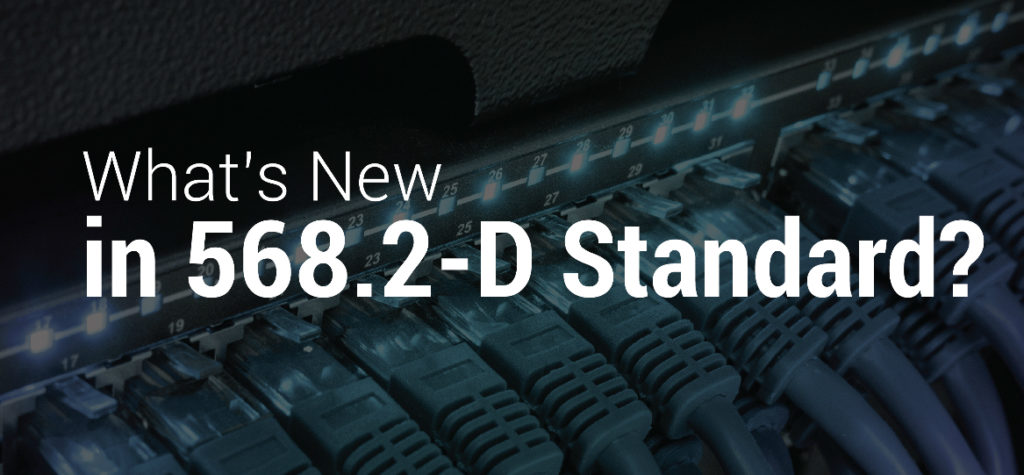Though fiber optic cables with higher bandwidths are becoming more popular, copper cabling is not retired now, since it has good conductivity and heat resistant with less cost. It’s widely used in horizontal cabling and PoE applications. Copper cabling installation is not as easy as thought. IT persons should follow the cabling standards made by ANSI/TIA to confirm the wiring patterns and cable performances. Last year, the latest TIA standard for balanced twisted pair cable system, ANSI/TIA-568.2-D, was approved for publication. Compared with the previous version TIA-568.C.2, the new standard brings some changes, like adding 28 AWG cables and MPTL configuration. This article will go over the most impactful updates.
ANSI/TIA-568.2-D Standard Introduction
TIA (Telecommunications Industry Association) creates standards and technical documents based on guidelines established by the essential requirements of ANSI (American National Standards Institute). ANSI/TIA-568.2-D specifies the mechanical and transmission requirement of patch cables like Cat6 Ethernet cable, Cat7 cable. Unlike previous naming convention (eg.568-C.2, letter “D” is in the front of number 2. Here 2 means the balanced twisted pair cable, C means the revision), this time TIA thought it would make more sense to put number first and the letter “D” last. The standard is not developed for end users or installers, just for the manufacturers. With ANSI/TIA-568.2-D standard, the compatibility and interoperability of products from different producers can be guaranteed, which is essential to keep networks running smoothly. So it’s important to figure out what the significant changes are in the new standard.
Changes in ANSI/TIA-568.-D Copper Cabling Standard
Compared with the previous edition TIA-568-C.2, there’re a few changes.
In the past standard, ANSI/TIA standards indicated that 28 AWG cable didn’t meet requirements, while the standards required twisted-pair structured cabling to use 22 AWG to 26 AWG cables as horizontal cable instead of using 28 AWG patch cable. But now, 28 AWG patch cords are recognized in a normative annex to TIA-568.2-D. This is good news for high density application. Because 28 AWG cables have almost half the diameter of the typical 24 AWG Ethernet cables, which can help reduce congestion, improve airflow and cable management around active equipment. Also, it enables a decreased bend radius which offers flexibility for easier move, adds and changes. But note that, 28 AWG patch cables have higher insertion loss which is directly related to the length of a channel. This means the use of 28 AWG cables requires reduced overall length of the channel. For example, when using 10 meters of 28 AWG cables, the total permanent link length is 82.5 meters.
MPTL (Modular Plug Terminated Link) is now recognized in the approved ANSI/TIA-568.2-D as an option for connecting devices. In the past, the horizontal cables is terminated in an outlet, then using patch cables to connect the networking devices. But now, the horizontal cables can connect directly to a device when it terminated on one end to an RJ45 plug. This configuration is especially practical when connecting surveillance cameras or wireless access points, since installing the traditional outlet for the devices is too difficult and expensive. MPTL also can improve performance and more efficient power delivery by eliminating the extra connection points introduced by outlets and patch cords.
This new standard adds Cat8 cabling and component requirements into the main document. Cat8 supports bandwidth of up to 2000MHz. This Ethernet cable speed can be up to 25/40Gbps with a maximum channel length of 30m. It’s the fastest Ethernet cable, which is not intended for office environments, but suitable for connecting equipment in data centers such as connecting server to switch.
TIA-568.2-D also includes guidelines for supporting Power Delivery Over Balanced Twisted Pair Cabling. This provides recommendations for twisted pair cables that will support the supply of DC power, particularly in response to the forthcoming IEEE 802.3bt standard.
Conclusion
ANSI/TIA-568.2-D standard is the new foundation for copper cabling. It will drive industry change, such as promoting the development of 28 AWG Ethernet cables and MPTL configuration. If you’re planning on upgrading your structured cabling system, talk to FS first. FS offers you the newest 28 AWG Cat5e patch cables and cat6 patch cables which meet the new standard, providing a unique and useful cable management solution for today’s enterprise and data center environments.
